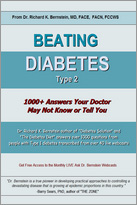How and When to Measure Blood Sugar
The nondiabetic body is constantly measuring its levels of blood sugar and compensating for values that are either too high or too low. A diabetic’s body has lost much or all of this capability. With a little help from technology, you can take over where your body has left off and do what it once did automatically normalize your blood sugars.
YOUR BLOOD GLUCOSE PROFILE
No matter how mild your diabetes may be, it is very unlikely that any physician can tell you how to normalize your blood sugars throughout the day without knowing what your blood glucose values are around the clock. Don’t believe anyone who tells you otherwise. The only way to know what your around the clock levels are is to monitor them yourself.
A table of blood sugar levels, with associated events (meals, exercise, and so on), measured at least 4 times daily over a number of days, is the key element in what is called a blood glucose profile. This pro-file, described in detail in the next chapter, gives you and your physician or diabetes educator a glimpse of how your medication, lifestyle, and diet converge, and how they affect your blood sugars. Without this information, it’s impossible to come up with a treatment plan that will normalize blood sugars. Except in emergencies, I try not to treat someone’s diabetes until I receive a blood glucose profile that covers at least one week.
Blood glucose data, together with information about meals, medication, exercise, and any other pertinent data that affect blood sugar, is best recorded on the Glucograf II data sheet, illustrated on page 82.
How Frequently Are Glucose Profiles Necessary?
If your treatment includes insulin injections before each meal, your diabetes is probably severe enough to render it impossible for your body to automatically correct small deviations from a target blood glucose range. To achieve blood sugar normalization, it therefore may be necessary for you to record blood glucose profiles every day for the rest of your life, so that you can fine tune any out of range values. If you are not treated with insulin, or if you have a very mild form of insulin treated diabetes, it may only be necessary to prepare blood glucose profiles when needed for readjustment of your diet or medication. Typically, this might be for one to two weeks prior to every routine follow up visit to your physician, and for a few weeks while your treatment plan is being fine tuned for the first time. After all, your physician or diabetes educator cannot tell if a new regimen is working properly without seeing your blood glucose profiles. It is wise, however, that you also do a blood glucose profile for 1 day at least every other week, so you will be assured that things are continuing as planned.
Selecting a Blood Glucose Measuring Outfit
The measuring system usually consists of a pocket-sized electronic meter with a liquid crystal display. The outfit will include a spring driven finger sticking device and a supply of lancets. The meter is designed for use with disposable plastic strips, onto or into which a drop of blood is placed. Some brands of strips change color when exposed to glucose, and the accompanying meter measures color change. Other strips contain electrodes that conduct or generate more or less current depending upon the amount of glucose in the blood.
About twenty different blood glucose metering outfits are presently being marketed in the United States. Only one or two of these currently have a degree of accuracy acceptable for our purposes. Some systems routinely report blood glucose values that are 40–100 percent in error. This can be very dangerous to the user. How these have secured approval from the Food and Drug Administration (FDA) is a matter of conjecture. Usually the problem involves poor quality control or poor design of the plastic strips, or inability to calibrate the meter accurately for different batches of strips.
Although your supplier should be in a position to advise you properly on the selection of systems for blood glucose monitoring, this is almost never the case. Even physicians and educators specializing in diabetes rarely conduct the studies necessary to evaluate these products. Reports in medical journals that purport to be evaluating different blood glucose self measurement systems are frequently financed by one of the manufacturers and often present grossly deceptive conclusions. All this puts you, the consumer, in a difficult position.
Designs advance so rapidly that it’s impossible to predict what will be available when you read this book. I frequently compare new meters for accuracy versus a major clinical lab. I also check the reproducibility of results. You can call our Diabetes Center at (914) 698-7525 Monday through Thursday between 9:30 a.m. and 3:30 p.m. Eastern time (U.S.A.) to find out what system we currently recommend for our patients.
Accuracy is the most important feature to keep in mind when selecting a meter, so do not be seduced by low cost, size, appearance, or special features, such as built in memory, built in lancet, or built in insulin injector. Buy from a dealer who will refund your money if the system is inaccurate. You can get a rough idea of the precision or reproducibility of results of the system by performing four blood glucose measurements in succession at the dealer’s store. They should be within 5 percent of one another when blood sugars are in the 70–120 mg/dl range. Ask your physician about the systems he has evaluated. He can secure virtually any system from its manufacturer for study at no cost.
A number of my patients have been tempted by advertising for blood sugar meters that contain a built-in device to puncture the skin at sites other than the fingertips (arms, buttocks, abdomen), where the puncture causes absolutely no pain. I have tested several of these products and found their blood sugar readings to be inaccurate. Far superior to these is the Bayer Vaculance for painless punctures of these alternate sites. I use it myself and a separate, very accurate meter. If blood sugar is changing rapidly, these alternate test site results may lag behind fingertip tests by as much as 20 minutes.
MEASURING YOUR BLOOD SUGARS:
IMPORTANT TECHNIQUES
Many instruction booklets give inadequate or erroneous instructions for preparing the finger or putting the drop of blood onto or into the test strip or electrode. If the instructions that follow conflict with what you’ve been told, believe mine. My techniques aren’t based on something I read in medical school or in a medical journal. They’re the ones I use on myself every day. I’ve been measuring my own blood sugars for nearly thirty five years and have performed more than 110,000 measurements.
1. If you’ve handled glucose tablets or any food since last washing your hands, wash them again. Invisible material on your fingers can cause erroneously high readings. Certainly wash your hands if they are soiled. If you are sitting in a car or some other place where you cannot wash your hands, lick the appropriate finger enthusiastically and dry it on a handkerchief or clothing. Don’t wipe your fingers with alcohol; this will dry out the skin and can eventually foster the formation of calluses.Neither I nor any of my patients have developed finger infections by not using alcohol.
2. Unless your fingers are already warm, it may be necessary to rinse them under warm water. Blood will flow much more readily from a warm finger.
3. Lay out all the supplies you will need at your work area. These usually include a finger stick device loaded with a lancet, your blood glucose meter, a blood glucose test strip, and a tissue for blotting your finger after the test. If you have no tissue, just suck off the blood (unless your religion forbids consuming human blood). Insert a disposable test strip into your blood sugar meter. (Some test strips are supplied in individual foil packets. The accompanying instruction booklet may tell you not to handle the strips directly but to hold them in the foil. This assumes that your hands are always dirty, which is absurd, since they must be clean for an accurate result.)
4. Many spring activated finger stick devices come with two rigid plastic covers for the end that touches your finger. Usually one cover is for thin or soft skin (as in small children), while the other is for thick or callused skin. To get a shallower puncture, use the thicker tipped cover; to get a deeper puncture, use the thinner tipped cover. An even deeper puncture may be obtained by strongly pressing your finger against the lancet cover. A very shallow puncture may be obtained by barely touching the fingertip to the cover. The pressure of the finger on the cover determines how deep the puncture will go. It should be deep enough to provide an adequate drop of blood, but not be so deep as to cause bruising or pain. Contrary to common teaching, the best sites for pricking fingers are actually on the back of the hand. Prick your finger between the first joint and the nail, or between the first and second joints (not over the knuckles), as shown by the shaded areas in Figure 4-1. Pricking these sites should be less likely to cause pain and more likely to produce a drop of blood than will pricking your fingers on the palmar side of the hand. You will also be free from the calluses that occur after repeated punctures on the palmar surface of the fingers.* When using this technique, I press the tip of the lancing device very gently against the finger, as the skin is thinner there than on the palmar surface. If you find it repugnant to prick the dorsum (knuckle side) of your fingers, use the sites on the palmar surface illustrated in Figure 4-2. Personally, I actually use all of the sites shown in both diagrams. As you will not be sharing your finger stick device, you need not discard the disposable plastic lancets with the metal point after every finger stick. It is a good idea to discard them once a month, as they do eventually become dull.
5. Over a period of time, you should use all the fingers of both hands. There is no reason to prefer one finger over the others. Once you have pricked your finger, squeeze it (use a rhythmic action rather than steady pressure) with the opposite hand until the drop of blood is about ¹/16 inch (2 mm) in diameter. If flow is inadequate (see items 7 and 8 below), perform a deeper finger stick.
6. Touch the drop of blood to the proper point on the test strip.*
7. Most meters will start an automatic countdown as soon as the strip has absorbed enough blood. The countdown, in seconds, usually appears on the display screen and concludes with the appearance of your blood glucose value. If your meter has a timer button, press it immediately after applying blood, without delay; do not stop to examine the strip in order to determine whether or not you have applied enough blood. (This comes later.) Since the accuracy of the test usually depends upon the timing, the delay between applying the blood and pressing the button should be no greater than 1 second. This doesn’t sound like much time, but you’ll be an old pro in short order.
8. Once the timer has started, you may examine the strip to make sure it is adequately covered or filled with blood. If it is not, discard the strip and start again.
9. If you get a little blood on your clothing, rub on a few drops of hydrogen peroxide with a handkerchief.Wait for the foaming to stop. Then blot and repeat the process. Continue until blood has disappeared. This works best while the blood is still wet.
10. When your meter finishes its countdown (or countup, depending on the model), your blood sugar will be shown on the display screen. Write it down on your Glucograf II data sheet as instructed in Chapter 5.
* My patients and I are much indebted to Mr. Ron Raab, president of the International Diabetes Institute of Caulfield, Australia, for this not so obvious technique. Mr. Raab’s attempts to publish this important finding were repeatedly scorned by medical journals and finally came to my attention via personal correspondence. I use Mr. Raab’s technique myself and find it far superior to the palmar technique, which I used for years. By the way, this technique was in common use by physicians seventy years ago. Like so many things in medicine, it had to be rediscovered.
* At least one manufacturer (Bayer) provides strips that have an invisible hole at their tip. Blood is sucked into the strip by capillary action. The puncture site should point upward and the tip of the strip must be inserted into the drop of blood.With such strips, the blood should not be put on top of the strip as erroneously practiced by many users.
11. If you are measuring someone else’s blood sugars using your personal equipment (not a wise practice), install a fresh lancet each time, and wipe off the end cap of the finger stick device with fresh bleach after each use. It is possible to transmit serious infectious diseases from one person to another via finger sticks. The entire process, from pricking the finger to a final reading, takes as little as 5 seconds, and rarely more than 1 minute.
PREPARING FOR YOUR FIRST BLOOD SUGAR CONTROL VISIT TO YOUR PHYSICIAN OR DIABETES EDUCATOR
Make sure you have all the supplies you and your physician have checked off in Chapter 3. Put a string on your finger to remind you to ask someone at the doctor’s office to watch you measure your blood sugar and to correct any errors you may make. (About 80 percent of my new patients are not measuring their blood sugars accurately when I first see them.) Bring along at least two weeks’ worth of your blood glucose profiles. Ideally, these should be written on Glucograf II data sheets (see next chapter), which have been designed for quick review by the physician or other health care professional. To compile
your profiles, blood sugars should be measured:
• Upon rising in the morning
• Immediately before breakfast
• Five hours after every injection of rapid acting insulin (if you use one of these before meals or to cover elevated blood sugars); otherwise, before each meal
• Two hours after meals and snacks (if you do not take rapidacting insulin before meals)
• At bedtime
• Before and after exercising, shopping, or running errands
• Whenever you are hungry or suspect that your blood glucose may be higher or lower than usual. Once your blood sugars have been fine tuned, it may not be necessary for you to check them 2 hours after meals and immediately before breakfast. Appropriate times for testing will be specified in subsequent chapters.




